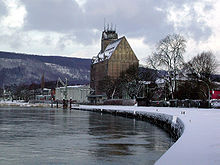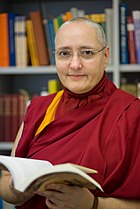Holzminden
 From Wikipedia the free encyclopedia
From Wikipedia the free encyclopedia
Holzminden | |
|---|---|
 A view over the town in autumn | |
| Coordinates: 51°49′47″N 09°26′54″E / 51.82972°N 9.44833°E | |
| Country | Germany |
| State | Lower Saxony |
| District | Holzminden |
| Government | |
| • Mayor (2021–26) | Christian Belke[1] |
| Area | |
| • Total | 88.25 km2 (34.07 sq mi) |
| Elevation | 89 m (292 ft) |
| Population (2022-12-31)[2] | |
| • Total | 20,120 |
| • Density | 230/km2 (590/sq mi) |
| Time zone | UTC+01:00 (CET) |
| • Summer (DST) | UTC+02:00 (CEST) |
| Postal codes | 37603 |
| Dialling codes | 05531 |
| Website | www |
Holzminden (German pronunciation: [hɔltsˈmɪndən] ; Low German: Holtsminne) is a town in southern Lower Saxony, Germany. It is the capital of the district of Holzminden. It is located on the river Weser, which at this point forms the border with the state of North Rhine-Westphalia.
History
[edit]Holzminden is first mentioned in the 9th century as Holtesmeni. However, the name did not at this time refer to the present city, but to the village of Altendorf, the "old village", which was incorporated into the city in 1922.
During the reign of Louis the Pious (814–840), monks from the Abbey of Corbie in France came to this part of Germany and founded a daughter house at Hethis in the Solling. As it became clear that this site was unviable (owing to lack of access to water) it was abandoned, and a new monastery, Corbeia nova (Corvey Abbey), opened close to the river. Old documents show that many pious donations were given to the Holtesmeni (monastery).
The settlement is believed to have come into being, along with other settlements in the vicinity, in the 6th-7th centuries. Other villages were subsequently abandoned as Holzminden was granted municipal liberties, allowing greater privileges to its inhabitants, and attracting new settlers from the surrounding hinterland.
In 1200, the town was brought under the protection of the prince's castle of Everstein, and by 1245 it had received a charter. This was granted by the count of Everstein.[3] The town's coat of arms shows the Everstein lion rampant within the open town gate.
From 1408, the town belonged to the Welfen princes; and from the 16th century to the princes of Brunswick of the Wolfenbüttel line. From the 16th century until 1942, Holzminden therefore lay within Brunswick-Lüneburg.
In 1640, during the Thirty Years' War, the town was destroyed by the Imperial troops, a blow from which it only slowly recovered. Until the 20th century Holzminden remained a provincial town of small farmers and holdings.
During World War I, Holzminden was the site of a large civilian internment camp on the outskirts of the town, which held up to 10,000 Polish, Russian, Belgian and French nationals, including women and children (1914–1918); and also of a smaller prisoner-of-war camp for 500–600 captured British and British Empire officers (1917–1918).
Economy
[edit]


Crafts and farming have long ceased to be the main town's sources of income. Holzminden is now a largely industrial town.
In the late 19th century, Dr. Wilhelm Haarmann began developing the scent and flavours industry. In 1874, with Ferdinand Tiemann, he succeeded in synthesising vanillin from coniferyl alcohol. More products were subsequently developed. The modern successor of their enterprise is the Symrise factory: Holzminden is a centre of the flavour and fragrance ingredient industry, its products being used throughout the world in cosmetic and food manufacture.
The large Stiebel Eltron company, which produces heating and hot water products, has its headquarters in Holzminden.
Owens-Illinois operates a glassworks in the town.
Religion
[edit]As a part of the former territory of Brunswick, Holzminden maintains a Protestant tradition. The church of St. Pauls in Altendorf, dating from before 1200, is the oldest of the town's churches. In its unadorned simplicity it offers a serene place for rest and contemplation. Other churches in the town are named after Luther, St. Michael, St. Thomas and St. Joseph(catholic).
Sights
[edit]
The Tilly House of 1609 is located on Johannis Square. It has a fine Renaissance door, which survived the fires of the Thirty Years' War. Johann Tserclaes, Count of Tilly, commander of the Imperial forces, is said to have spent a night here.
The Reichspräsidentenhaus links the old part of the town with the Hafendamm and was opened in 1929. The beautiful Glockenspiel (carillon) is very popular, and plays well known tunes at set times.
The steeple of the Lutheran church has become a symbol of Holzminden. The interior was remodelled in 1577, when it was made into a two-room church.
The Severinsche Haus is a richly decorated house dating from 1683. It is the largest of the bourgeois houses, is decorated with a distinctive weathercock, and is known for its slanting floors.
There is a good viewing platform on the Emperor William Tower, south of the town.
Museums
[edit]- The town museum
- The doll and toy museum (private)
Educational institutions
[edit]- HAWK, the Hochschule für angewandte Wissenschaft und Kunst, was founded in 1831/32 by Friedrich Ludwig Haarmann as the first college of architecture in Germany. The Bauschule is now a prominent feature of the town, and many student activities, such as the traditional master's procession, are regular events on the Holzminden calendar.[4]
- LSH, the Internat Solling, is a private boarding school founded in 1909 as part of an educational reform movement that sought to cultivate "Mind, Heart and Hand" equally. The campus occupies large open grounds on a western slope of the Solling.[5]
- Campe-Gymnasium. A Gymnasium is an advanced secondary school with an emphasis on academic learning.
- The other secondary schools are the Dr. Jasper-Realschule and the Johannes-Falk-Schule (Hauptschule).
- There are also a Förderschule, Schule an der Weser and Anne-Frank-Schule.
International relations
[edit]Holzminden is twinned with:
Notable people
[edit]

- Heinrich Grimm (ca1592-1637), a late-Renaissance / early-Baroque German composer, cantor and organist.
- Robert Bunsen (1811–1899), chemist, developed the Bunsen burner; went to school locally
- Wilhelm Konrad Hermann Müller (1812–1890), a philologist of Germanic studies
- Wilhelm Raabe (1831–1910), novelist, born in nearby Eschershausen
- August Hampe (1866–1945), politician, Minister of Justice of the Braunschweig District
- Erwin Böhme (1879–1917), World War I flying ace
- Nikolaus von Falkenhorst (1885–1968), Generaloberst, occupied Norway, 1940/1944, convicted war criminal; died locally
- Carl-Wilhelm Gerberding (1894–1984), industrialist and founder of Dragoco
- Adolf Heusinger (1897–1982), German general and Chairman of the NATO Military Committee
- Wilhelm Karl Prinz von Preussen (1922–2007), Prince of Prussia, died locally
- Niels Jannasch (1924–2001), mariner, curator and founding director of the Maritime Museum of the Atlantic
- Eberhard Itzenplitz (1926–2012), film director
- Ulrich Brinkhoff (born 1940), photographer and writer
- Jonatan Briel (1942–1988), film director and actor
- Carola Roloff (born 1959), Buddhist nun, Tibetologist, University Professor
- Uwe Schünemann (born 1964), CDU politician and Minister of Lower Saxony
- Christian Meyer (born 1975), politician for the Alliance '90/The Greens and Minister of Lower Saxony
Sport
[edit]- Jyhan Artut (born 1976), darts player
- Nicolas Kiefer (born 1977), tennis player
- Annika Roloff (born 1991), athlete who specializes in the pole vault
See also
[edit]- Holzminden internment camp
- Holzminden prisoner-of-war camp
- Holzminden (district)
- Metropolitan region Hannover-Braunschweig-Göttingen-Wolfsburg
References
[edit]- ^ "Direktwahlen in Niedersachsen vom 12. September 2021" (PDF). Landesamt für Statistik Niedersachsen. 13 October 2021.
- ^ "LSN-Online Regionaldatenbank, Tabelle A100001G: Fortschreibung des Bevölkerungsstandes, Stand 31. Dezember 2022" (in German). Landesamt für Statistik Niedersachsen.
- ^ Chisholm, Hugh, ed. (1911). . Encyclopædia Britannica. Vol. 13 (11th ed.). Cambridge University Press. p. 624.
- ^ "Hochschule für angewandte Wissenschaft und Kunst". Archived from the original on 2017-01-16. Retrieved 2006-11-14.
- ^ Internat Solling




